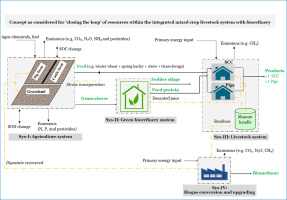Science of the Total Environment ( IF 8.2 ) Pub Date : 2017-11-13 , DOI: 10.1016/j.scitotenv.2017.11.082 Ranjan Parajuli , Tommy Dalgaard , Morten Birkved

|
This study evaluates environmental impacts of an integrated mixed crop-livestock system with a green biorefinery (GBR). System integration included production of feed crops and green biomasses (Sys-I) to meet the demand of a livestock system (Sys-III) and to process green biomasses in a GBR system (Sys-II). Processing of grass-clover to produce feed protein was considered in Sys-II, particularly to substitute the imported soybean meal. Waste generated from the livestock and GBR systems were considered for the conversion to biomethane (Sys-IV). Digestate produced therefrom was assumed to be recirculated back to the farmers' field (Sys-I). A consequential approach of Life Cycle Assessment (LCA) method was used to evaluate the environmental impacts of a combined production of suckler cow calves (SCC) and Pigs, calculated in terms of their live weight (LW). The functional unit (FU) was a basket of two products “1 kgLW-SCC + 1 kgLW-Pigs”, produced at the farm gate. Results obtained per FU were: 19.6 kg CO2 eq for carbon footprint; 0.11 kg PO4 eq for eutrophication potential, − 129 MJ eq for non-renewable energy use and − 3.9 comparative toxicity units (CTUe) for potential freshwater ecotoxicity. Environmental impact, e.g. greenhouse gas (GHG) emission was primarily due to (i) N2O emission and diesel consumption within Sys-I, (ii) energy input to Sys-II, III and IV, and (iii) methane emission from Sys-III and Sys-IV. Specifically, integrating GBR with the mixed crop-livestock system contributed 4% of the GHG emissions, whilst its products credited 7% of the total impact. Synergies among the different sub-systems showed positive environmental gains for the selected main products. The main effects of the system integration were in the reductions of GHG emissions, fossil fuel consumption, eutrophication potential and freshwater ecotoxicity, compared to a conventional mixed crop-livestock system, without the biogas conversion facility and the GBR.
中文翻译:

农民可以通过粮食,燃料和饲料的联合生产减轻环境影响吗?带有绿色生物精炼厂的农作物-畜牧综合系统的生命周期评估
这项研究评估了具有绿色生物精炼厂(GBR)的农作物-畜牧混合系统的综合环境影响。系统集成包括生产饲料作物和绿色生物量(Sys-I),以满足牲畜系统(Sys-III)的需求,并在GBR系统(Sys-II)中处理绿色生物量。在Sys-II中考虑了用草三叶草生产饲料蛋白的方法,特别是替代了进口的豆粕。考虑将牲畜和GBR系统产生的废物转化为生物甲烷(Sys-IV)。假定由此产生的Digestate被再循环回农民田间(Sys-I)。使用生命周期评估(LCA)方法的结果方法来评估奶牛犊(SCC)和猪的联合生产对环境的影响,根据其活重(LW)计算。功能单元(FU)是一篮子两个产品,重量为1千克LW -SCC + 1公斤LW -Pigs”,在农场大门处生产。每个FU获得的结果是:碳足迹为19.6 kg CO 2当量;富营养化潜力为0.11 kg PO 4 eq,不可再生能源利用为-129 MJ eq ,潜在的淡水生态毒性为-3.9比较毒性单位(CTU e)。环境影响,例如温室气体(GHG)排放主要是由于(i)N 2Sys-I内的O排放量和柴油消耗量;(ii)Sys-II,III和IV的能量输入,以及(iii)Sys-III和Sys-IV的甲烷排放量。具体而言,将GBR与农作物-畜牧混合系统相结合,贡献了4%的温室气体排放,而其产品贡献了7%的总影响。不同子系统之间的协同作用表明,所选主要产品在环境方面取得了积极的收益。与没有沼气转化设施和GBR的常规农作物-畜牧混合系统相比,系统集成的主要效果是减少了温室气体排放,减少了化石燃料的消耗,富营养化潜力和淡水生态毒性。










































 京公网安备 11010802027423号
京公网安备 11010802027423号